Cloud Computing: Security, Technologies, and Applications Report
VerifiedAdded on 2019/09/25
|12
|2208
|291
Report
AI Summary
This report provides a comprehensive overview of cloud computing, focusing on its security issues and challenges. It begins by highlighting the benefits of cloud computing, such as improved cost efficiencies and scalability, while also addressing the primary concerns related to data security and privacy, including loss of control over data, dependence on the cloud provider, and various security vulnerabilities. The report then delves into specific challenges like data service outsourcing security, computation outsourcing security, and access control. It further explores current cloud computing technologies, namely IaaS, PaaS, SaaS, HuaaS, and XaaS, detailing their functionalities and applications. The report illustrates the applications of these technologies, especially SaaS, PaaS, and IaaS, in different scenarios. Finally, it concludes with recommendations for managing and mitigating security risks in cloud environments, emphasizing the importance of risk management, legal compliance, and secure communication channels between customers and providers. The report aims to provide a clear understanding of the cloud computing landscape and offers insights into the security aspects that need careful consideration for a secure cloud environment.
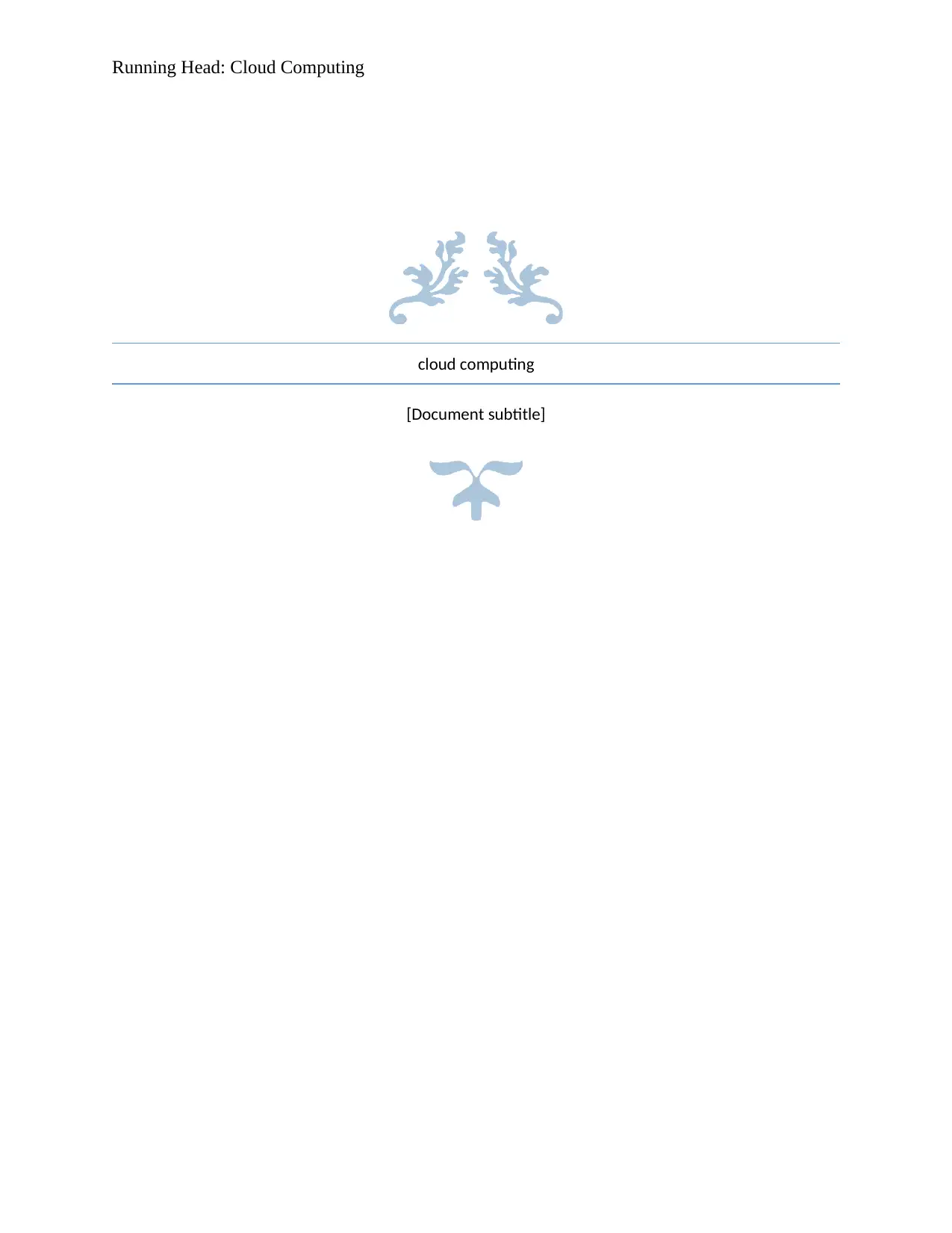
Running Head: Cloud Computing
cloud computing
[Document subtitle]
cloud computing
[Document subtitle]
Paraphrase This Document
Need a fresh take? Get an instant paraphrase of this document with our AI Paraphraser
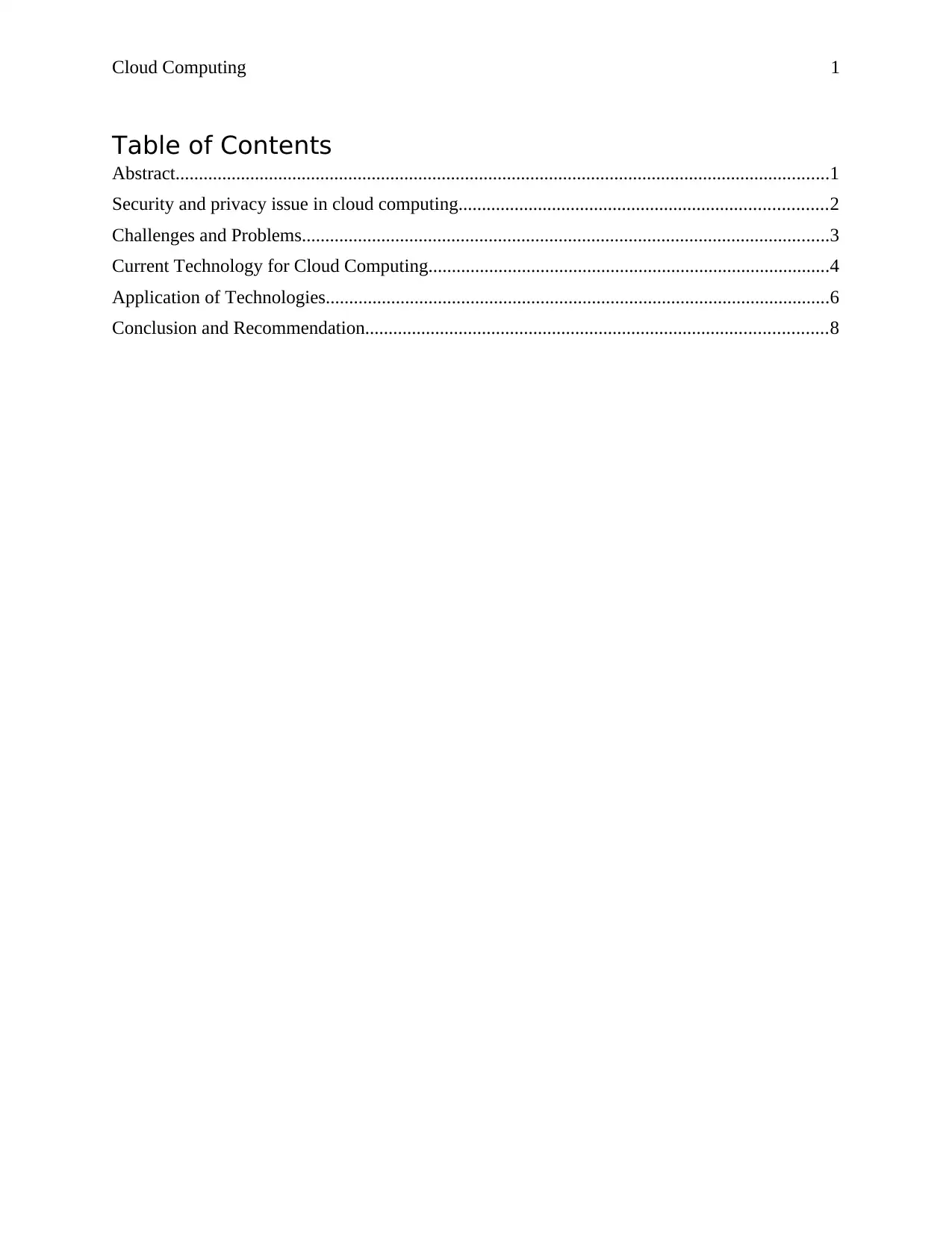
Cloud Computing 1
Table of Contents
Abstract............................................................................................................................................1
Security and privacy issue in cloud computing...............................................................................2
Challenges and Problems.................................................................................................................3
Current Technology for Cloud Computing......................................................................................4
Application of Technologies............................................................................................................6
Conclusion and Recommendation...................................................................................................8
Table of Contents
Abstract............................................................................................................................................1
Security and privacy issue in cloud computing...............................................................................2
Challenges and Problems.................................................................................................................3
Current Technology for Cloud Computing......................................................................................4
Application of Technologies............................................................................................................6
Conclusion and Recommendation...................................................................................................8
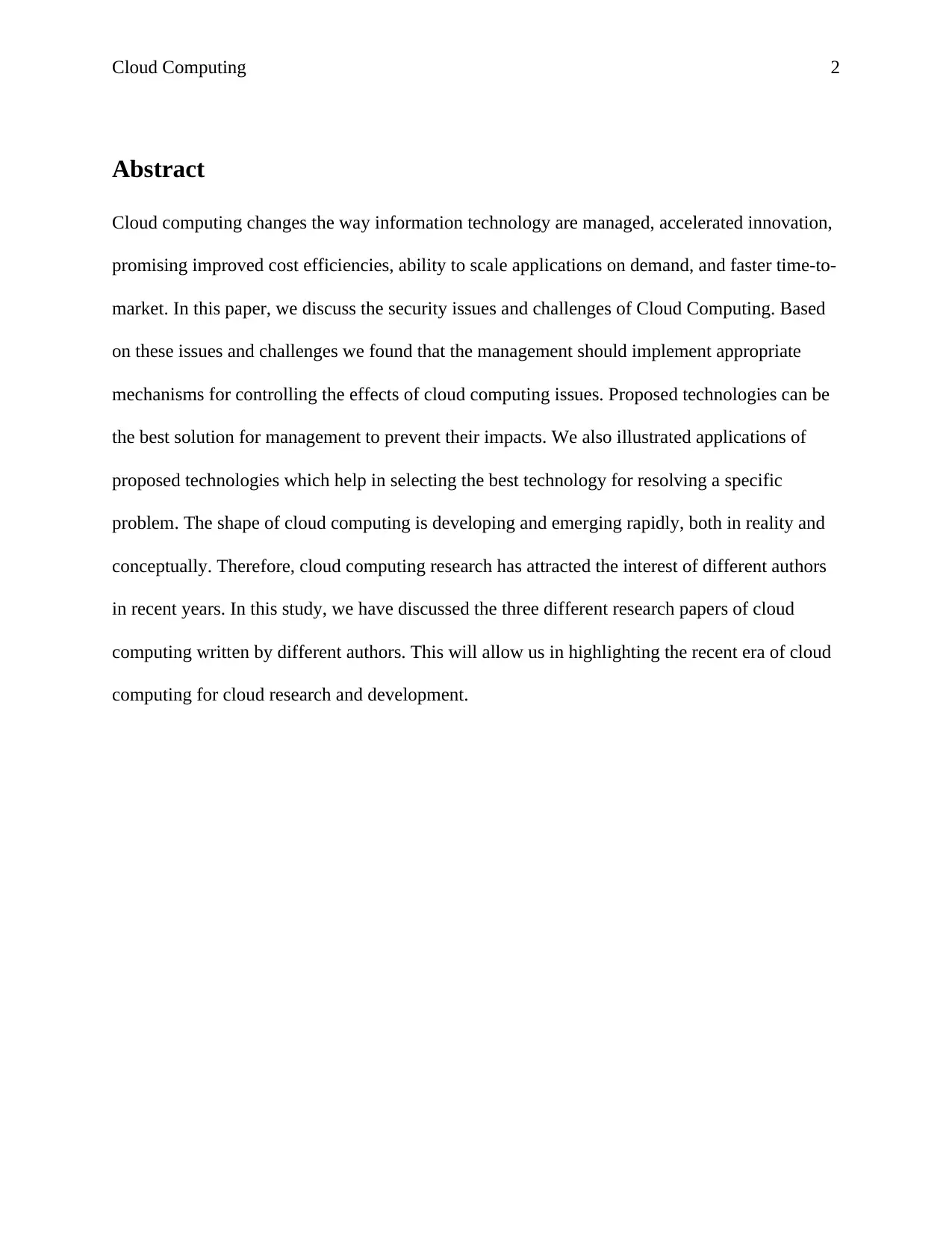
Cloud Computing 2
Abstract
Cloud computing changes the way information technology are managed, accelerated innovation,
promising improved cost efficiencies, ability to scale applications on demand, and faster time-to-
market. In this paper, we discuss the security issues and challenges of Cloud Computing. Based
on these issues and challenges we found that the management should implement appropriate
mechanisms for controlling the effects of cloud computing issues. Proposed technologies can be
the best solution for management to prevent their impacts. We also illustrated applications of
proposed technologies which help in selecting the best technology for resolving a specific
problem. The shape of cloud computing is developing and emerging rapidly, both in reality and
conceptually. Therefore, cloud computing research has attracted the interest of different authors
in recent years. In this study, we have discussed the three different research papers of cloud
computing written by different authors. This will allow us in highlighting the recent era of cloud
computing for cloud research and development.
Abstract
Cloud computing changes the way information technology are managed, accelerated innovation,
promising improved cost efficiencies, ability to scale applications on demand, and faster time-to-
market. In this paper, we discuss the security issues and challenges of Cloud Computing. Based
on these issues and challenges we found that the management should implement appropriate
mechanisms for controlling the effects of cloud computing issues. Proposed technologies can be
the best solution for management to prevent their impacts. We also illustrated applications of
proposed technologies which help in selecting the best technology for resolving a specific
problem. The shape of cloud computing is developing and emerging rapidly, both in reality and
conceptually. Therefore, cloud computing research has attracted the interest of different authors
in recent years. In this study, we have discussed the three different research papers of cloud
computing written by different authors. This will allow us in highlighting the recent era of cloud
computing for cloud research and development.
⊘ This is a preview!⊘
Do you want full access?
Subscribe today to unlock all pages.

Trusted by 1+ million students worldwide
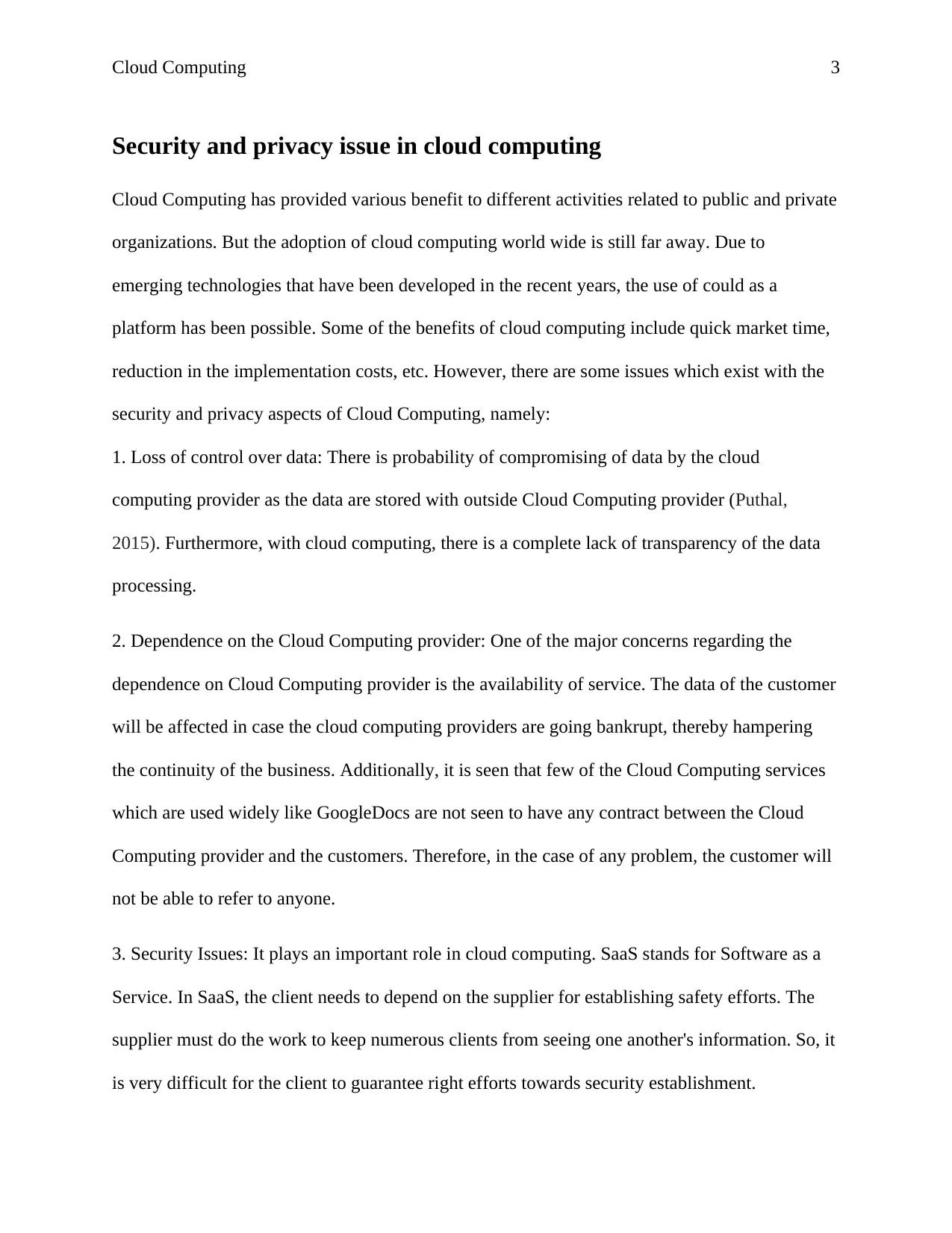
Cloud Computing 3
Security and privacy issue in cloud computing
Cloud Computing has provided various benefit to different activities related to public and private
organizations. But the adoption of cloud computing world wide is still far away. Due to
emerging technologies that have been developed in the recent years, the use of could as a
platform has been possible. Some of the benefits of cloud computing include quick market time,
reduction in the implementation costs, etc. However, there are some issues which exist with the
security and privacy aspects of Cloud Computing, namely:
1. Loss of control over data: There is probability of compromising of data by the cloud
computing provider as the data are stored with outside Cloud Computing provider (Puthal,
2015). Furthermore, with cloud computing, there is a complete lack of transparency of the data
processing.
2. Dependence on the Cloud Computing provider: One of the major concerns regarding the
dependence on Cloud Computing provider is the availability of service. The data of the customer
will be affected in case the cloud computing providers are going bankrupt, thereby hampering
the continuity of the business. Additionally, it is seen that few of the Cloud Computing services
which are used widely like GoogleDocs are not seen to have any contract between the Cloud
Computing provider and the customers. Therefore, in the case of any problem, the customer will
not be able to refer to anyone.
3. Security Issues: It plays an important role in cloud computing. SaaS stands for Software as a
Service. In SaaS, the client needs to depend on the supplier for establishing safety efforts. The
supplier must do the work to keep numerous clients from seeing one another's information. So, it
is very difficult for the client to guarantee right efforts towards security establishment.
Security and privacy issue in cloud computing
Cloud Computing has provided various benefit to different activities related to public and private
organizations. But the adoption of cloud computing world wide is still far away. Due to
emerging technologies that have been developed in the recent years, the use of could as a
platform has been possible. Some of the benefits of cloud computing include quick market time,
reduction in the implementation costs, etc. However, there are some issues which exist with the
security and privacy aspects of Cloud Computing, namely:
1. Loss of control over data: There is probability of compromising of data by the cloud
computing provider as the data are stored with outside Cloud Computing provider (Puthal,
2015). Furthermore, with cloud computing, there is a complete lack of transparency of the data
processing.
2. Dependence on the Cloud Computing provider: One of the major concerns regarding the
dependence on Cloud Computing provider is the availability of service. The data of the customer
will be affected in case the cloud computing providers are going bankrupt, thereby hampering
the continuity of the business. Additionally, it is seen that few of the Cloud Computing services
which are used widely like GoogleDocs are not seen to have any contract between the Cloud
Computing provider and the customers. Therefore, in the case of any problem, the customer will
not be able to refer to anyone.
3. Security Issues: It plays an important role in cloud computing. SaaS stands for Software as a
Service. In SaaS, the client needs to depend on the supplier for establishing safety efforts. The
supplier must do the work to keep numerous clients from seeing one another's information. So, it
is very difficult for the client to guarantee right efforts towards security establishment.
Paraphrase This Document
Need a fresh take? Get an instant paraphrase of this document with our AI Paraphraser
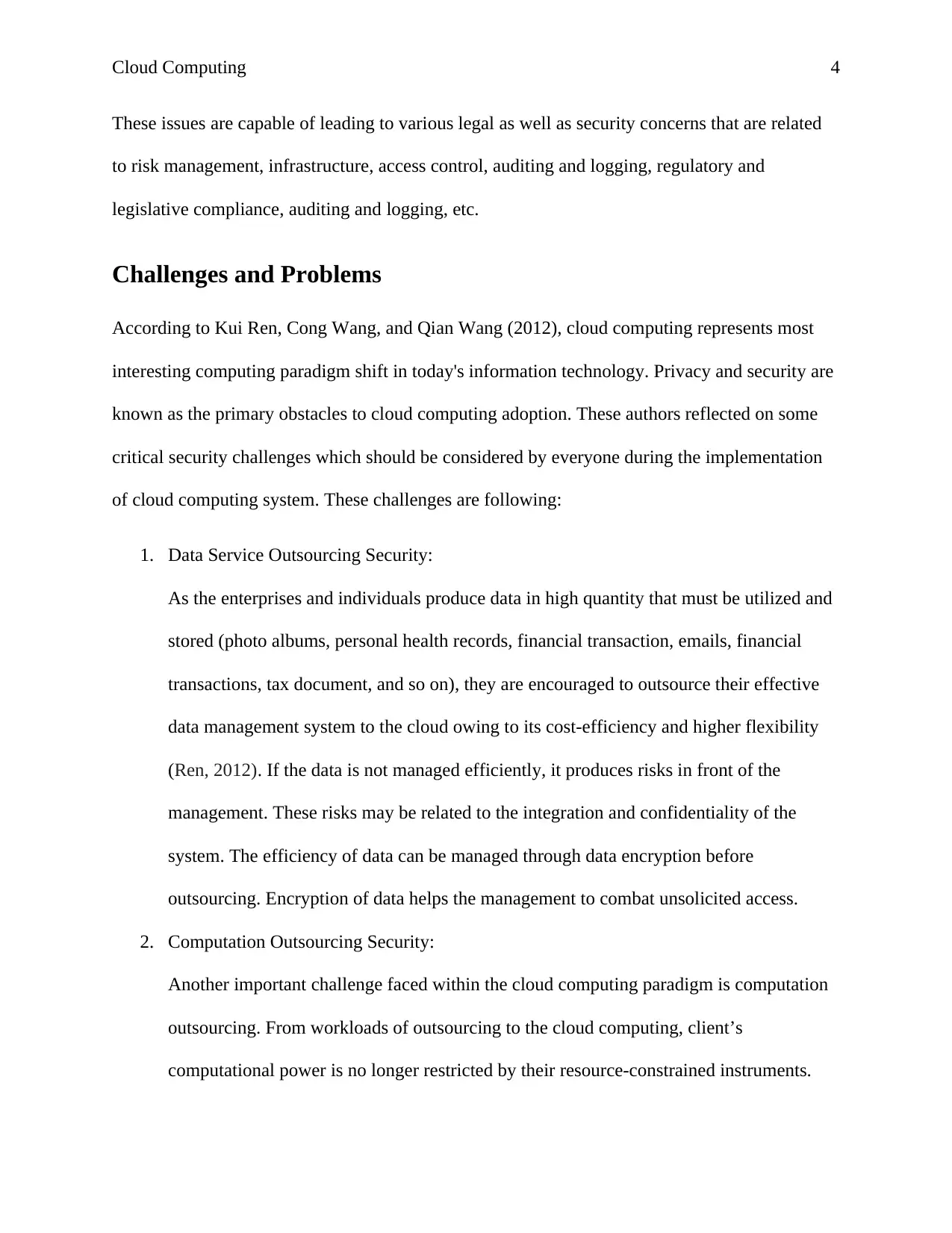
Cloud Computing 4
These issues are capable of leading to various legal as well as security concerns that are related
to risk management, infrastructure, access control, auditing and logging, regulatory and
legislative compliance, auditing and logging, etc.
Challenges and Problems
According to Kui Ren, Cong Wang, and Qian Wang (2012), cloud computing represents most
interesting computing paradigm shift in today's information technology. Privacy and security are
known as the primary obstacles to cloud computing adoption. These authors reflected on some
critical security challenges which should be considered by everyone during the implementation
of cloud computing system. These challenges are following:
1. Data Service Outsourcing Security:
As the enterprises and individuals produce data in high quantity that must be utilized and
stored (photo albums, personal health records, financial transaction, emails, financial
transactions, tax document, and so on), they are encouraged to outsource their effective
data management system to the cloud owing to its cost-efficiency and higher flexibility
(Ren, 2012). If the data is not managed efficiently, it produces risks in front of the
management. These risks may be related to the integration and confidentiality of the
system. The efficiency of data can be managed through data encryption before
outsourcing. Encryption of data helps the management to combat unsolicited access.
2. Computation Outsourcing Security:
Another important challenge faced within the cloud computing paradigm is computation
outsourcing. From workloads of outsourcing to the cloud computing, client’s
computational power is no longer restricted by their resource-constrained instruments.
These issues are capable of leading to various legal as well as security concerns that are related
to risk management, infrastructure, access control, auditing and logging, regulatory and
legislative compliance, auditing and logging, etc.
Challenges and Problems
According to Kui Ren, Cong Wang, and Qian Wang (2012), cloud computing represents most
interesting computing paradigm shift in today's information technology. Privacy and security are
known as the primary obstacles to cloud computing adoption. These authors reflected on some
critical security challenges which should be considered by everyone during the implementation
of cloud computing system. These challenges are following:
1. Data Service Outsourcing Security:
As the enterprises and individuals produce data in high quantity that must be utilized and
stored (photo albums, personal health records, financial transaction, emails, financial
transactions, tax document, and so on), they are encouraged to outsource their effective
data management system to the cloud owing to its cost-efficiency and higher flexibility
(Ren, 2012). If the data is not managed efficiently, it produces risks in front of the
management. These risks may be related to the integration and confidentiality of the
system. The efficiency of data can be managed through data encryption before
outsourcing. Encryption of data helps the management to combat unsolicited access.
2. Computation Outsourcing Security:
Another important challenge faced within the cloud computing paradigm is computation
outsourcing. From workloads of outsourcing to the cloud computing, client’s
computational power is no longer restricted by their resource-constrained instruments.
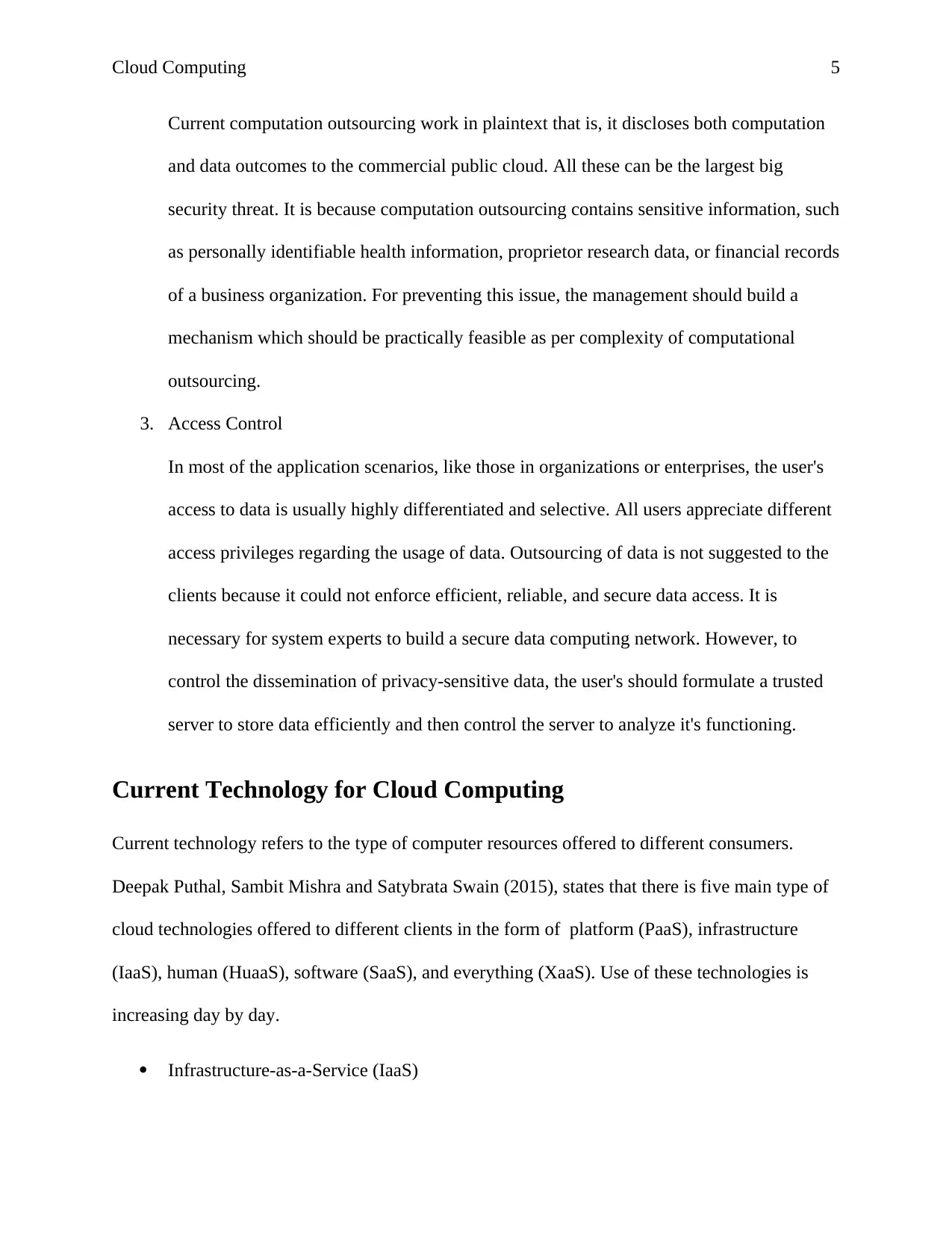
Cloud Computing 5
Current computation outsourcing work in plaintext that is, it discloses both computation
and data outcomes to the commercial public cloud. All these can be the largest big
security threat. It is because computation outsourcing contains sensitive information, such
as personally identifiable health information, proprietor research data, or financial records
of a business organization. For preventing this issue, the management should build a
mechanism which should be practically feasible as per complexity of computational
outsourcing.
3. Access Control
In most of the application scenarios, like those in organizations or enterprises, the user's
access to data is usually highly differentiated and selective. All users appreciate different
access privileges regarding the usage of data. Outsourcing of data is not suggested to the
clients because it could not enforce efficient, reliable, and secure data access. It is
necessary for system experts to build a secure data computing network. However, to
control the dissemination of privacy-sensitive data, the user's should formulate a trusted
server to store data efficiently and then control the server to analyze it's functioning.
Current Technology for Cloud Computing
Current technology refers to the type of computer resources offered to different consumers.
Deepak Puthal, Sambit Mishra and Satybrata Swain (2015), states that there is five main type of
cloud technologies offered to different clients in the form of platform (PaaS), infrastructure
(IaaS), human (HuaaS), software (SaaS), and everything (XaaS). Use of these technologies is
increasing day by day.
Infrastructure-as-a-Service (IaaS)
Current computation outsourcing work in plaintext that is, it discloses both computation
and data outcomes to the commercial public cloud. All these can be the largest big
security threat. It is because computation outsourcing contains sensitive information, such
as personally identifiable health information, proprietor research data, or financial records
of a business organization. For preventing this issue, the management should build a
mechanism which should be practically feasible as per complexity of computational
outsourcing.
3. Access Control
In most of the application scenarios, like those in organizations or enterprises, the user's
access to data is usually highly differentiated and selective. All users appreciate different
access privileges regarding the usage of data. Outsourcing of data is not suggested to the
clients because it could not enforce efficient, reliable, and secure data access. It is
necessary for system experts to build a secure data computing network. However, to
control the dissemination of privacy-sensitive data, the user's should formulate a trusted
server to store data efficiently and then control the server to analyze it's functioning.
Current Technology for Cloud Computing
Current technology refers to the type of computer resources offered to different consumers.
Deepak Puthal, Sambit Mishra and Satybrata Swain (2015), states that there is five main type of
cloud technologies offered to different clients in the form of platform (PaaS), infrastructure
(IaaS), human (HuaaS), software (SaaS), and everything (XaaS). Use of these technologies is
increasing day by day.
Infrastructure-as-a-Service (IaaS)
⊘ This is a preview!⊘
Do you want full access?
Subscribe today to unlock all pages.

Trusted by 1+ million students worldwide
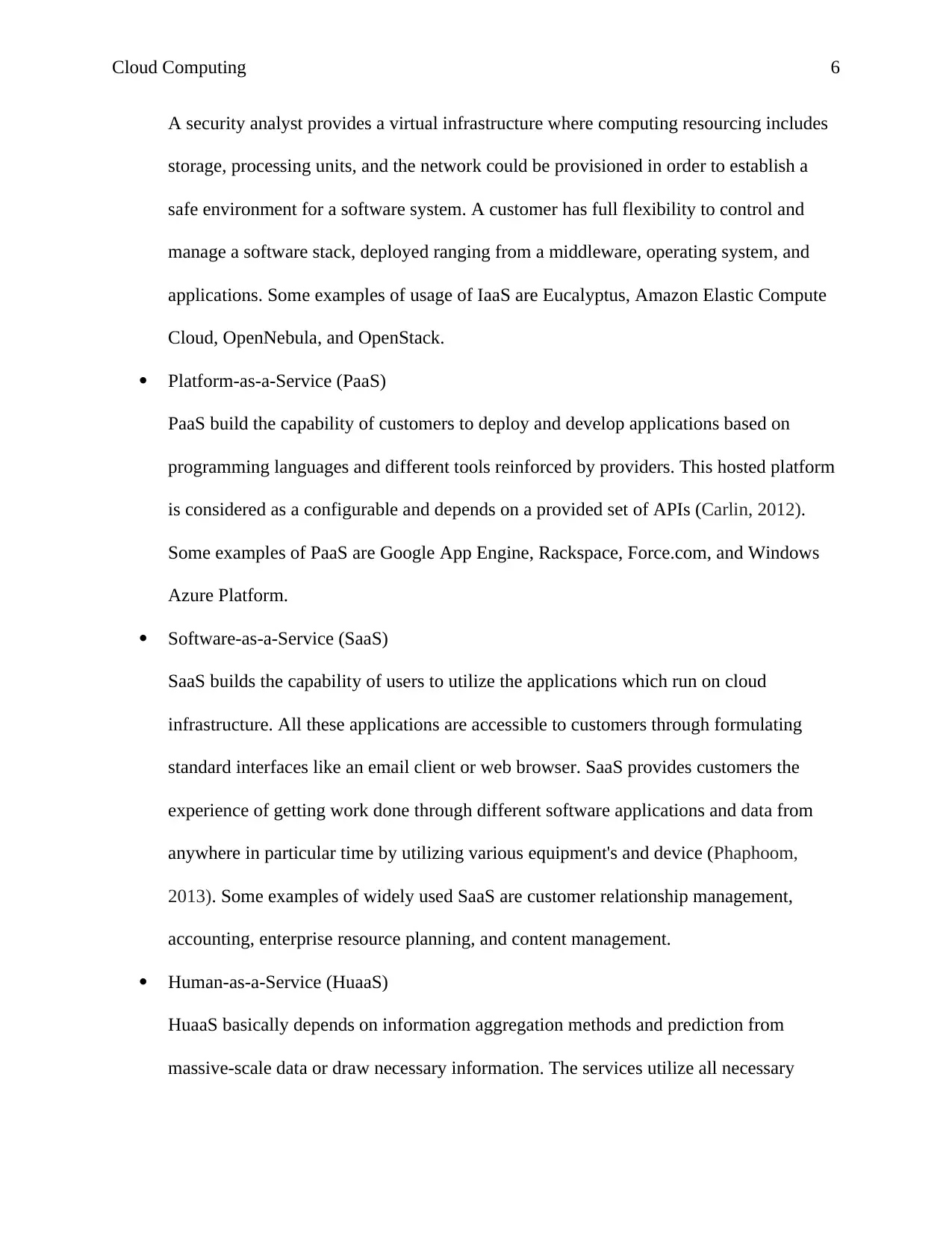
Cloud Computing 6
A security analyst provides a virtual infrastructure where computing resourcing includes
storage, processing units, and the network could be provisioned in order to establish a
safe environment for a software system. A customer has full flexibility to control and
manage a software stack, deployed ranging from a middleware, operating system, and
applications. Some examples of usage of IaaS are Eucalyptus, Amazon Elastic Compute
Cloud, OpenNebula, and OpenStack.
Platform-as-a-Service (PaaS)
PaaS build the capability of customers to deploy and develop applications based on
programming languages and different tools reinforced by providers. This hosted platform
is considered as a configurable and depends on a provided set of APIs (Carlin, 2012).
Some examples of PaaS are Google App Engine, Rackspace, Force.com, and Windows
Azure Platform.
Software-as-a-Service (SaaS)
SaaS builds the capability of users to utilize the applications which run on cloud
infrastructure. All these applications are accessible to customers through formulating
standard interfaces like an email client or web browser. SaaS provides customers the
experience of getting work done through different software applications and data from
anywhere in particular time by utilizing various equipment's and device (Phaphoom,
2013). Some examples of widely used SaaS are customer relationship management,
accounting, enterprise resource planning, and content management.
Human-as-a-Service (HuaaS)
HuaaS basically depends on information aggregation methods and prediction from
massive-scale data or draw necessary information. The services utilize all necessary
A security analyst provides a virtual infrastructure where computing resourcing includes
storage, processing units, and the network could be provisioned in order to establish a
safe environment for a software system. A customer has full flexibility to control and
manage a software stack, deployed ranging from a middleware, operating system, and
applications. Some examples of usage of IaaS are Eucalyptus, Amazon Elastic Compute
Cloud, OpenNebula, and OpenStack.
Platform-as-a-Service (PaaS)
PaaS build the capability of customers to deploy and develop applications based on
programming languages and different tools reinforced by providers. This hosted platform
is considered as a configurable and depends on a provided set of APIs (Carlin, 2012).
Some examples of PaaS are Google App Engine, Rackspace, Force.com, and Windows
Azure Platform.
Software-as-a-Service (SaaS)
SaaS builds the capability of users to utilize the applications which run on cloud
infrastructure. All these applications are accessible to customers through formulating
standard interfaces like an email client or web browser. SaaS provides customers the
experience of getting work done through different software applications and data from
anywhere in particular time by utilizing various equipment's and device (Phaphoom,
2013). Some examples of widely used SaaS are customer relationship management,
accounting, enterprise resource planning, and content management.
Human-as-a-Service (HuaaS)
HuaaS basically depends on information aggregation methods and prediction from
massive-scale data or draw necessary information. The services utilize all necessary
Paraphrase This Document
Need a fresh take? Get an instant paraphrase of this document with our AI Paraphraser
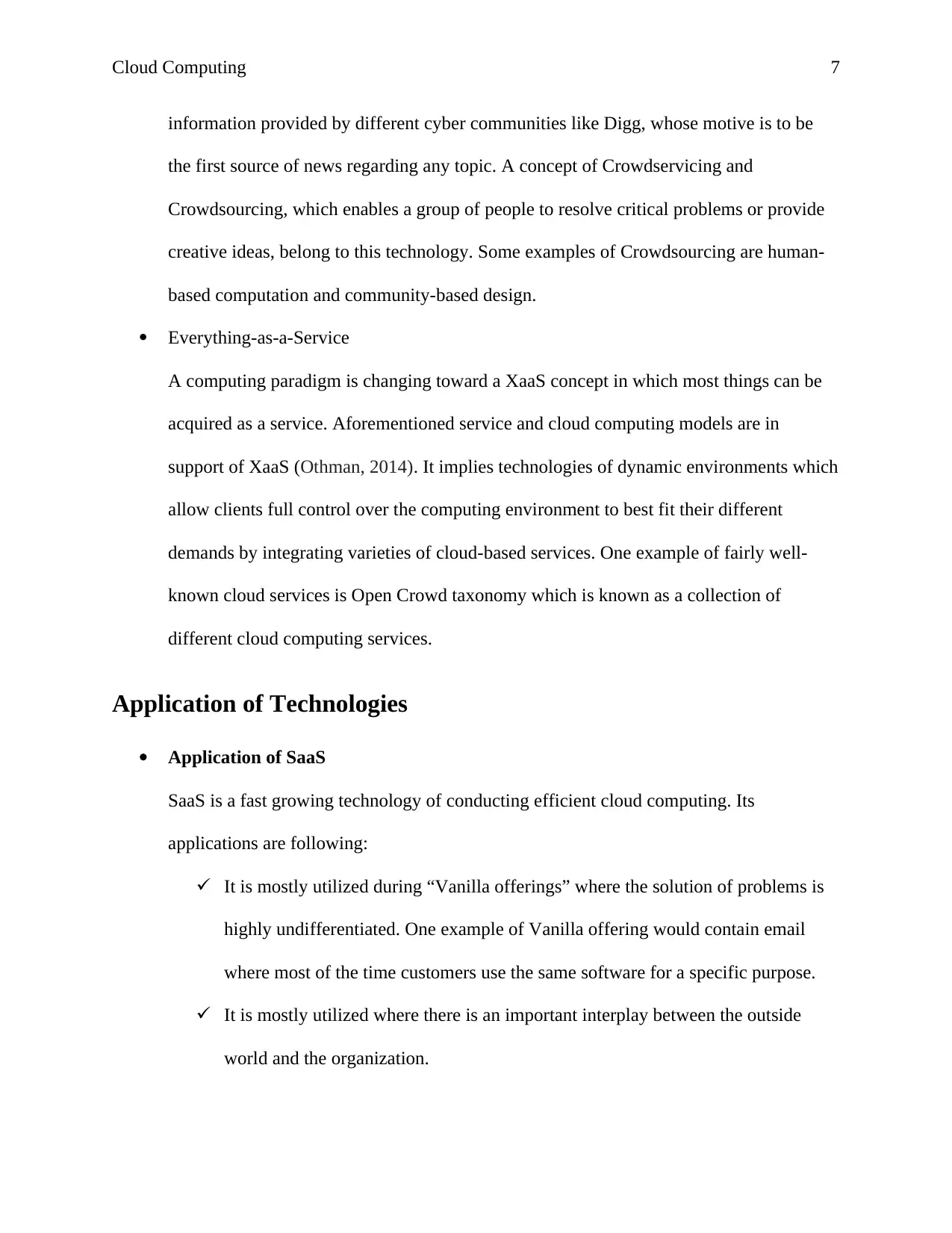
Cloud Computing 7
information provided by different cyber communities like Digg, whose motive is to be
the first source of news regarding any topic. A concept of Crowdservicing and
Crowdsourcing, which enables a group of people to resolve critical problems or provide
creative ideas, belong to this technology. Some examples of Crowdsourcing are human-
based computation and community-based design.
Everything-as-a-Service
A computing paradigm is changing toward a XaaS concept in which most things can be
acquired as a service. Aforementioned service and cloud computing models are in
support of XaaS (Othman, 2014). It implies technologies of dynamic environments which
allow clients full control over the computing environment to best fit their different
demands by integrating varieties of cloud-based services. One example of fairly well-
known cloud services is Open Crowd taxonomy which is known as a collection of
different cloud computing services.
Application of Technologies
Application of SaaS
SaaS is a fast growing technology of conducting efficient cloud computing. Its
applications are following:
It is mostly utilized during “Vanilla offerings” where the solution of problems is
highly undifferentiated. One example of Vanilla offering would contain email
where most of the time customers use the same software for a specific purpose.
It is mostly utilized where there is an important interplay between the outside
world and the organization.
information provided by different cyber communities like Digg, whose motive is to be
the first source of news regarding any topic. A concept of Crowdservicing and
Crowdsourcing, which enables a group of people to resolve critical problems or provide
creative ideas, belong to this technology. Some examples of Crowdsourcing are human-
based computation and community-based design.
Everything-as-a-Service
A computing paradigm is changing toward a XaaS concept in which most things can be
acquired as a service. Aforementioned service and cloud computing models are in
support of XaaS (Othman, 2014). It implies technologies of dynamic environments which
allow clients full control over the computing environment to best fit their different
demands by integrating varieties of cloud-based services. One example of fairly well-
known cloud services is Open Crowd taxonomy which is known as a collection of
different cloud computing services.
Application of Technologies
Application of SaaS
SaaS is a fast growing technology of conducting efficient cloud computing. Its
applications are following:
It is mostly utilized during “Vanilla offerings” where the solution of problems is
highly undifferentiated. One example of Vanilla offering would contain email
where most of the time customers use the same software for a specific purpose.
It is mostly utilized where there is an important interplay between the outside
world and the organization.
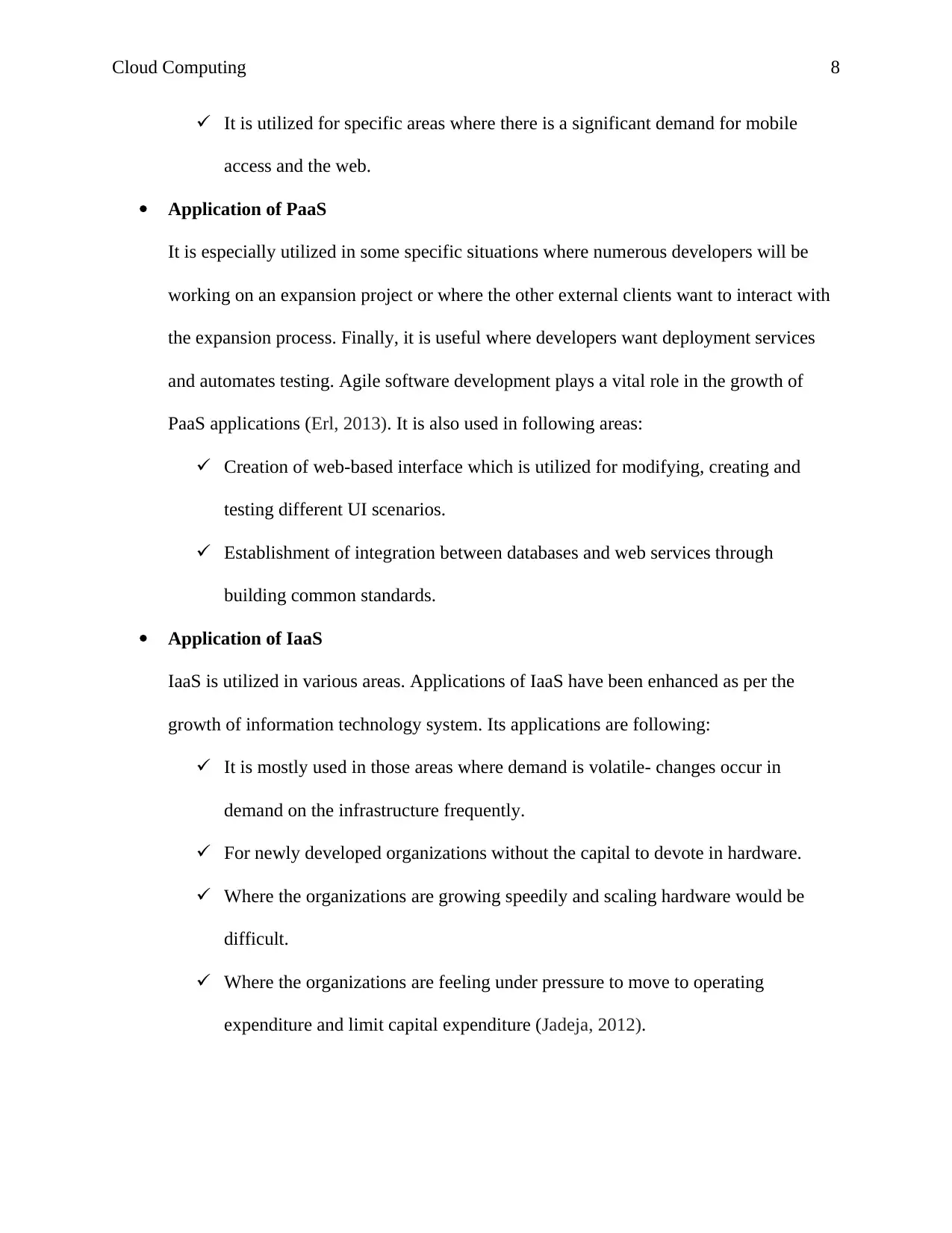
Cloud Computing 8
It is utilized for specific areas where there is a significant demand for mobile
access and the web.
Application of PaaS
It is especially utilized in some specific situations where numerous developers will be
working on an expansion project or where the other external clients want to interact with
the expansion process. Finally, it is useful where developers want deployment services
and automates testing. Agile software development plays a vital role in the growth of
PaaS applications (Erl, 2013). It is also used in following areas:
Creation of web-based interface which is utilized for modifying, creating and
testing different UI scenarios.
Establishment of integration between databases and web services through
building common standards.
Application of IaaS
IaaS is utilized in various areas. Applications of IaaS have been enhanced as per the
growth of information technology system. Its applications are following:
It is mostly used in those areas where demand is volatile- changes occur in
demand on the infrastructure frequently.
For newly developed organizations without the capital to devote in hardware.
Where the organizations are growing speedily and scaling hardware would be
difficult.
Where the organizations are feeling under pressure to move to operating
expenditure and limit capital expenditure (Jadeja, 2012).
It is utilized for specific areas where there is a significant demand for mobile
access and the web.
Application of PaaS
It is especially utilized in some specific situations where numerous developers will be
working on an expansion project or where the other external clients want to interact with
the expansion process. Finally, it is useful where developers want deployment services
and automates testing. Agile software development plays a vital role in the growth of
PaaS applications (Erl, 2013). It is also used in following areas:
Creation of web-based interface which is utilized for modifying, creating and
testing different UI scenarios.
Establishment of integration between databases and web services through
building common standards.
Application of IaaS
IaaS is utilized in various areas. Applications of IaaS have been enhanced as per the
growth of information technology system. Its applications are following:
It is mostly used in those areas where demand is volatile- changes occur in
demand on the infrastructure frequently.
For newly developed organizations without the capital to devote in hardware.
Where the organizations are growing speedily and scaling hardware would be
difficult.
Where the organizations are feeling under pressure to move to operating
expenditure and limit capital expenditure (Jadeja, 2012).
⊘ This is a preview!⊘
Do you want full access?
Subscribe today to unlock all pages.

Trusted by 1+ million students worldwide
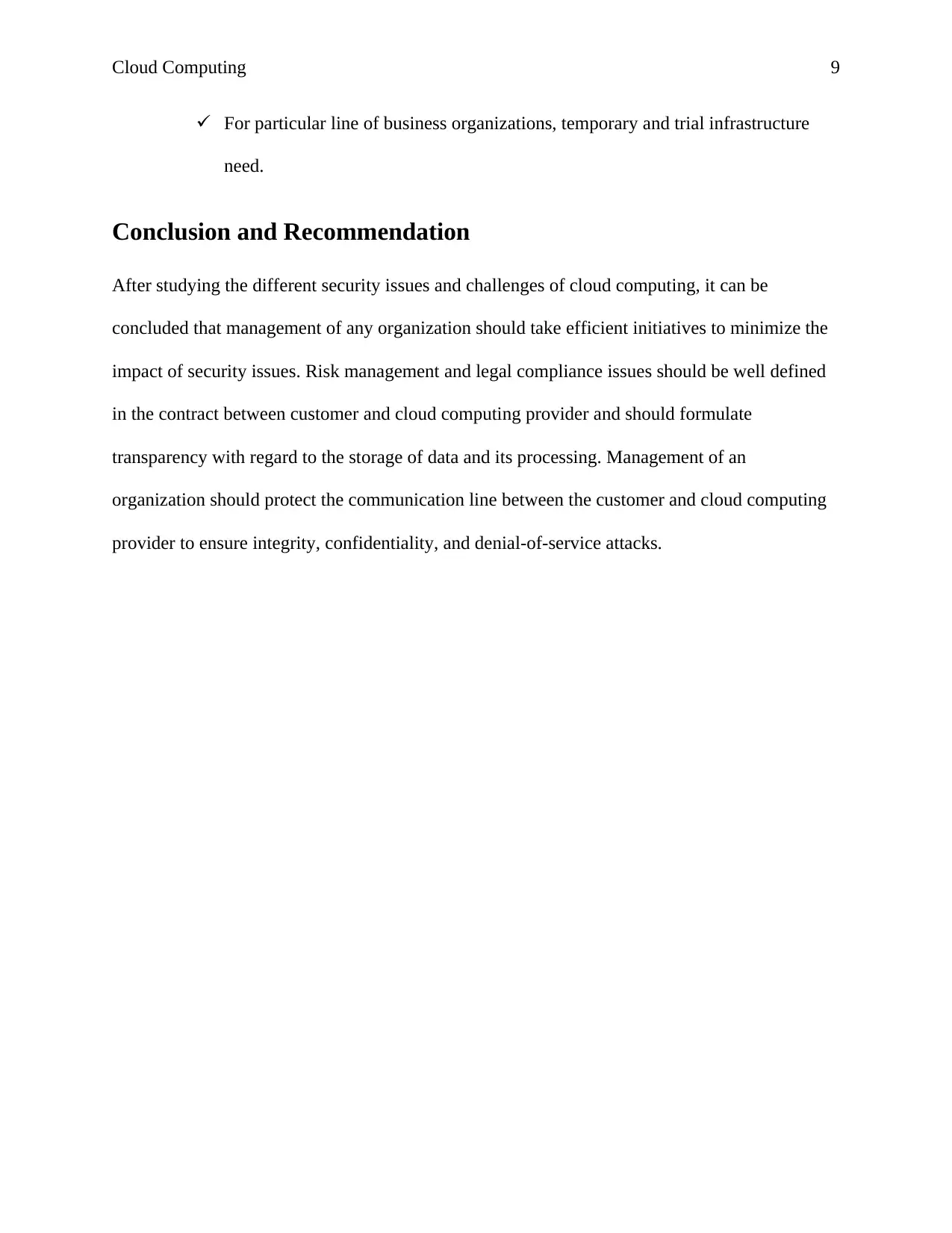
Cloud Computing 9
For particular line of business organizations, temporary and trial infrastructure
need.
Conclusion and Recommendation
After studying the different security issues and challenges of cloud computing, it can be
concluded that management of any organization should take efficient initiatives to minimize the
impact of security issues. Risk management and legal compliance issues should be well defined
in the contract between customer and cloud computing provider and should formulate
transparency with regard to the storage of data and its processing. Management of an
organization should protect the communication line between the customer and cloud computing
provider to ensure integrity, confidentiality, and denial-of-service attacks.
For particular line of business organizations, temporary and trial infrastructure
need.
Conclusion and Recommendation
After studying the different security issues and challenges of cloud computing, it can be
concluded that management of any organization should take efficient initiatives to minimize the
impact of security issues. Risk management and legal compliance issues should be well defined
in the contract between customer and cloud computing provider and should formulate
transparency with regard to the storage of data and its processing. Management of an
organization should protect the communication line between the customer and cloud computing
provider to ensure integrity, confidentiality, and denial-of-service attacks.
Paraphrase This Document
Need a fresh take? Get an instant paraphrase of this document with our AI Paraphraser
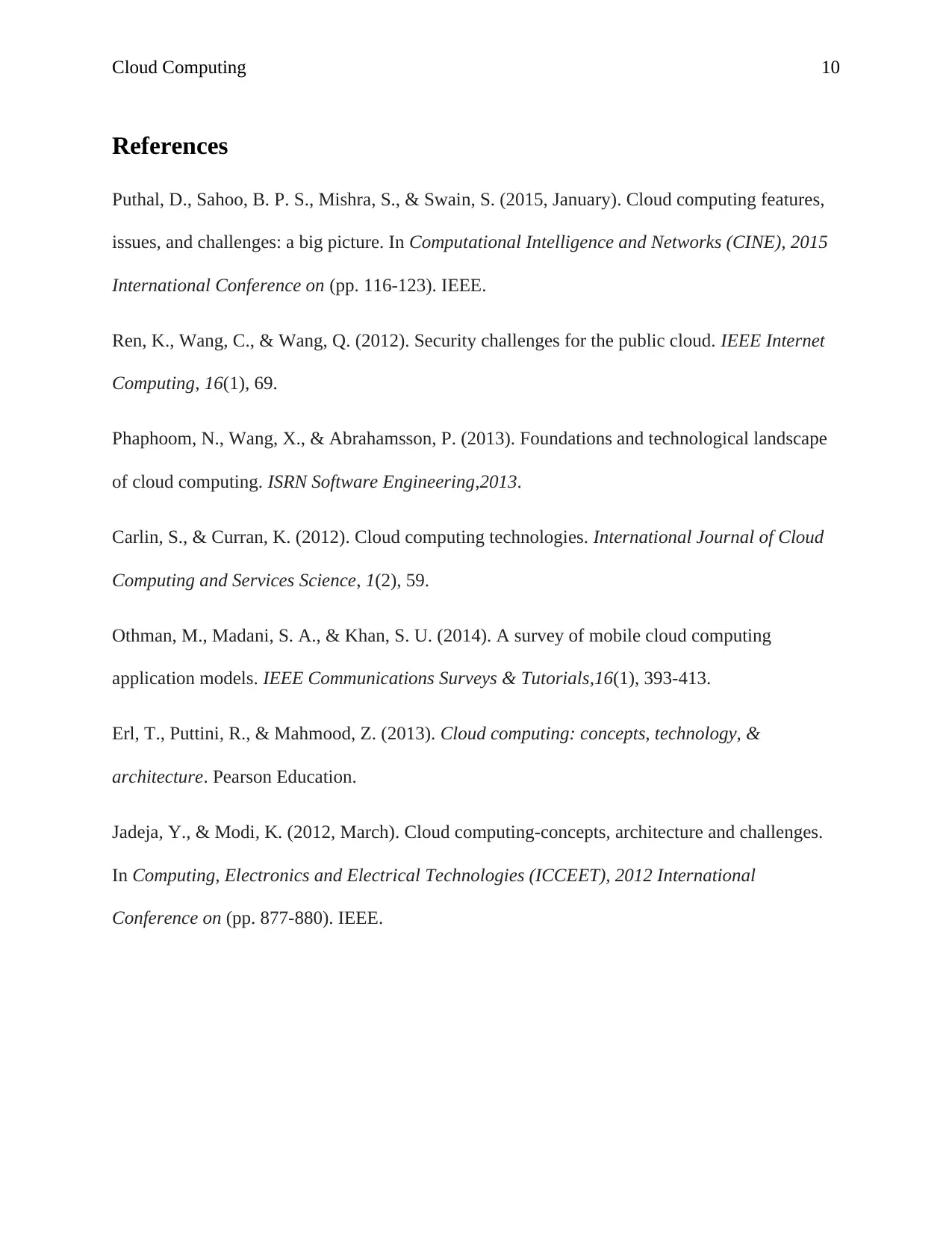
Cloud Computing 10
References
Puthal, D., Sahoo, B. P. S., Mishra, S., & Swain, S. (2015, January). Cloud computing features,
issues, and challenges: a big picture. In Computational Intelligence and Networks (CINE), 2015
International Conference on (pp. 116-123). IEEE.
Ren, K., Wang, C., & Wang, Q. (2012). Security challenges for the public cloud. IEEE Internet
Computing, 16(1), 69.
Phaphoom, N., Wang, X., & Abrahamsson, P. (2013). Foundations and technological landscape
of cloud computing. ISRN Software Engineering,2013.
Carlin, S., & Curran, K. (2012). Cloud computing technologies. International Journal of Cloud
Computing and Services Science, 1(2), 59.
Othman, M., Madani, S. A., & Khan, S. U. (2014). A survey of mobile cloud computing
application models. IEEE Communications Surveys & Tutorials,16(1), 393-413.
Erl, T., Puttini, R., & Mahmood, Z. (2013). Cloud computing: concepts, technology, &
architecture. Pearson Education.
Jadeja, Y., & Modi, K. (2012, March). Cloud computing-concepts, architecture and challenges.
In Computing, Electronics and Electrical Technologies (ICCEET), 2012 International
Conference on (pp. 877-880). IEEE.
References
Puthal, D., Sahoo, B. P. S., Mishra, S., & Swain, S. (2015, January). Cloud computing features,
issues, and challenges: a big picture. In Computational Intelligence and Networks (CINE), 2015
International Conference on (pp. 116-123). IEEE.
Ren, K., Wang, C., & Wang, Q. (2012). Security challenges for the public cloud. IEEE Internet
Computing, 16(1), 69.
Phaphoom, N., Wang, X., & Abrahamsson, P. (2013). Foundations and technological landscape
of cloud computing. ISRN Software Engineering,2013.
Carlin, S., & Curran, K. (2012). Cloud computing technologies. International Journal of Cloud
Computing and Services Science, 1(2), 59.
Othman, M., Madani, S. A., & Khan, S. U. (2014). A survey of mobile cloud computing
application models. IEEE Communications Surveys & Tutorials,16(1), 393-413.
Erl, T., Puttini, R., & Mahmood, Z. (2013). Cloud computing: concepts, technology, &
architecture. Pearson Education.
Jadeja, Y., & Modi, K. (2012, March). Cloud computing-concepts, architecture and challenges.
In Computing, Electronics and Electrical Technologies (ICCEET), 2012 International
Conference on (pp. 877-880). IEEE.
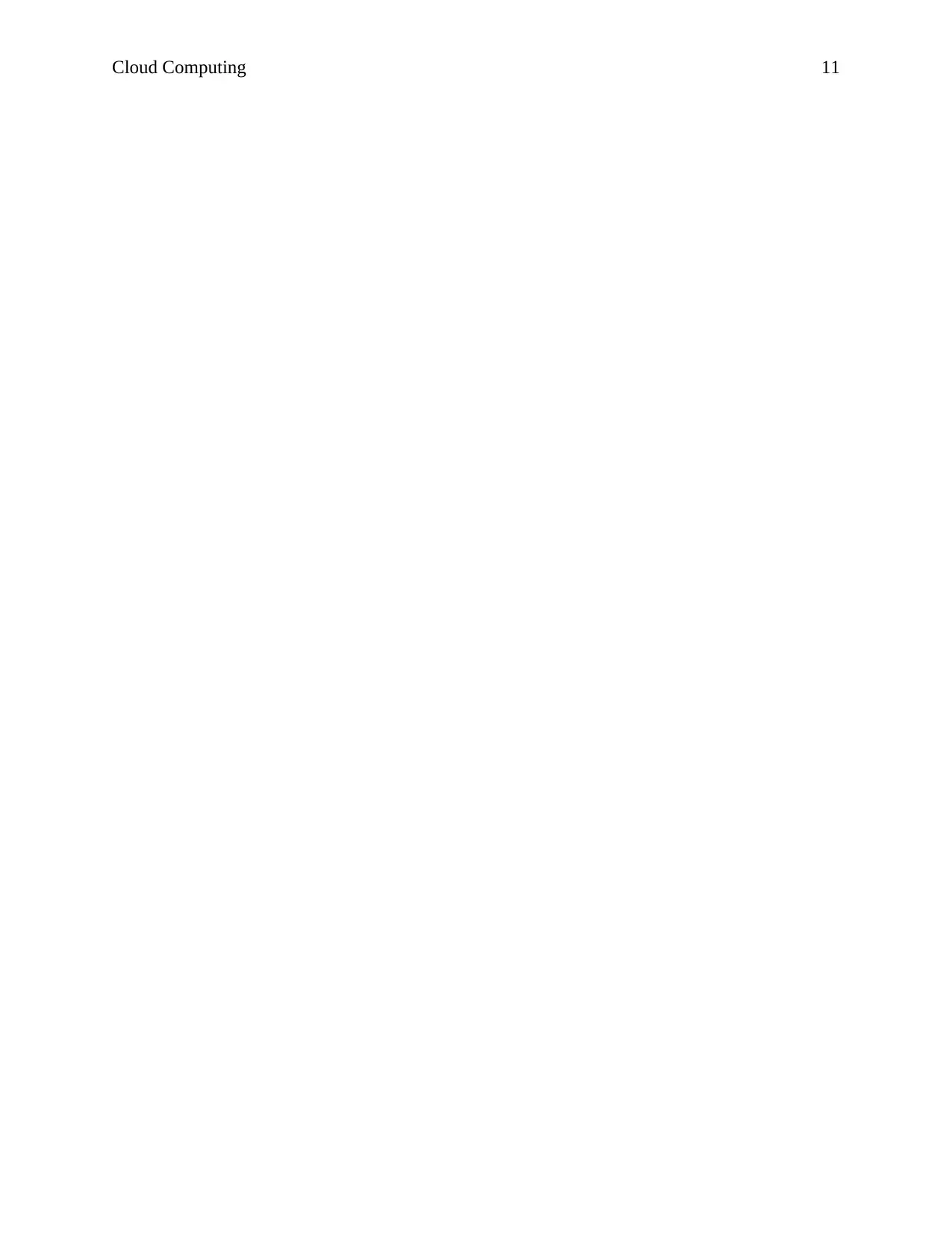
Cloud Computing 11
⊘ This is a preview!⊘
Do you want full access?
Subscribe today to unlock all pages.

Trusted by 1+ million students worldwide
1 out of 12
Related Documents
Your All-in-One AI-Powered Toolkit for Academic Success.
+13062052269
info@desklib.com
Available 24*7 on WhatsApp / Email
![[object Object]](/_next/static/media/star-bottom.7253800d.svg)
Unlock your academic potential
Copyright © 2020–2025 A2Z Services. All Rights Reserved. Developed and managed by ZUCOL.





